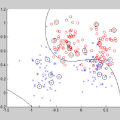一行TensorFlow/Keras代码解决真实场景中数据不平衡(imbalanced)问题
【导读】数据不平衡是最令数据挖掘工程师头疼的问题之一。例如在某些真实场景中,一个二分类问题的训练集可能仅包含1%的正样本,导致难以训练高性能分类器。本文介绍TensorFlow/Keras中的一种简单的应对数据不平衡的方法,仅需添加一行代码。
在真实场景和比赛中,数据不平衡的情况是普遍存在的。如果不使用一定的策略,而直接用不平衡的数据来训练分类器,可能会导致分类器性能大幅度降低。Keras作者François Chollet在Twitter上推荐了一个示例,展示了TensorFlow/Keras的一个解决数据不平衡问题的机制:
该示例在Kaggle信用卡欺诈数据集上训练分类模型,数据集极度不平衡(99.82%负样本 vs 0.18%正样本)。
依赖安装
代码依赖于TensorFlow 2.0 Preview,可以用下面命令安装:
!pip install tf-nightly-gpu-2.0-preview
核心代码
首先我们需要统计每种类别包含的样本数量,并基于此计算类别权重:
# 计算每种类别数据的数量
counts = np.bincount(train_targets[:, 0])
# 基于数量计算类别权重
weight_for_0 = 1. / counts[0]
weight_for_1 = 1. / counts[1]
class_weight = {0: weight_for_0, 1: weight_for_1}
在训练时,加上一行代码设置类别权重即可:
model.fit(train_features, train_targets,
batch_size=2048,
epochs=50,
verbose=2,
callbacks=callbacks,
validation_data=(val_features, val_targets),
# 设置类别权重
class_weight=class_weight)
完整代码
代码地址:
https://colab.research.google.com/drive/1xL2jSdY-MGlN60gGuSH_L30P7kxxwUfM
代码内容:
# -*- coding: utf-8 -*-
"""## First, vectorize the CSV data"""
import csv
import numpy as np
# Get the real data from https://www.kaggle.com/mlg-ulb/creditcardfraud/downloads/creditcardfraud.zip/
fname = '/Users/fchollet/Downloads/creditcard.csv'
all_features = []
all_targets = []
with open(fname) as f:
for i, line in enumerate(f):
if i == 0:
print('HEADER:', line.strip())
continue # Skip header
fields = line.strip().split(',')
all_features.append([float(v.replace('"', '')) for v in fields[:-1]])
all_targets.append([int(fields[-1].replace('"', ''))])
if i == 1:
print('EXAMPLE FEATURES:', all_features[-1])
features = np.array(all_features, dtype='float32')
targets = np.array(all_targets, dtype='uint8')
print('features.shape:', features.shape)
print('targets.shape:', targets.shape)
"""## Prepare a validation set"""
num_val_samples = int(len(features) * 0.2)
train_features = features[:-num_val_samples]
train_targets = targets[:-num_val_samples]
val_features = features[-num_val_samples:]
val_targets = targets[-num_val_samples:]
print('Number of training samples:', len(train_features))
print('Number of validation samples:', len(val_features))
"""## Analyze class imbalance in the targets"""
counts = np.bincount(train_targets[:, 0])
print('Number of positive samples in training data: {} ({:.2f}% of total)'.format(counts[1],
100 * float(counts[1]) / len(
train_targets)))
weight_for_0 = 1. / counts[0]
weight_for_1 = 1. / counts[1]
"""## Normalize the data using training set statistics"""
mean = np.mean(train_features, axis=0)
train_features -= mean
val_features -= mean
std = np.std(train_features, axis=0)
train_features /= std
val_features /= std
from tensorflow import keras
model = keras.Sequential([
keras.layers.Dense(256, activation='relu',
input_shape=(train_features.shape[-1],)),
keras.layers.Dense(256, activation='relu'),
keras.layers.Dropout(0.3),
keras.layers.Dense(256, activation='relu'),
keras.layers.Dropout(0.3),
keras.layers.Dense(1, activation='sigmoid'),
])
model.summary()
metrics = [keras.metrics.FalseNegatives(name='fn'),
keras.metrics.FalsePositives(name='fp'),
keras.metrics.TrueNegatives(name='tn'),
keras.metrics.TruePositives(name='tp'),
keras.metrics.Precision(name='precision'),
keras.metrics.Recall(name='recall')]
model.compile(optimizer=keras.optimizers.Adam(1e-2),
loss='binary_crossentropy',
metrics=metrics)
callbacks = [keras.callbacks.ModelCheckpoint('fraud_model_at_epoch_{epoch}.h5')]
class_weight = {0: weight_for_0, 1: weight_for_1}
model.fit(train_features, train_targets,
batch_size=2048,
epochs=50,
verbose=2,
callbacks=callbacks,
validation_data=(val_features, val_targets),
class_weight=class_weight)
参考链接:
https://colab.research.google.com/drive/1xL2jSdY-MGlN60gGuSH_L30P7kxxwUfM
-END-
专 · 知
专知,专业可信的人工智能知识分发,让认知协作更快更好!欢迎登录www.zhuanzhi.ai,注册登录专知,获取更多AI知识资料!
欢迎微信扫一扫加入专知人工智能知识星球群,获取最新AI专业干货知识教程视频资料和与专家交流咨询!
请加专知小助手微信(扫一扫如下二维码添加),加入专知人工智能主题群,咨询技术商务合作~

专知《深度学习:算法到实战》课程全部完成!550+位同学在学习,现在报名,限时优惠!网易云课堂人工智能畅销榜首位!
点击“阅读原文”,了解报名专知《深度学习:算法到实战》课程







